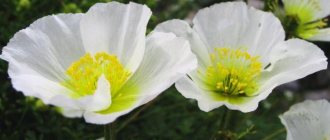Home House and cottage Garden and vegetable garden
Being in a garden and seeing beautiful roses is certainly a pleasure because it helps us contemplate the beauty of these magnificent flowers. Roses are many people's favorite flowers - they are elegant, classic flowers that bring life to any place where they are present. One of the most popular varieties of roses are bush roses, which have taken root especially well in Russia.
Shrub roses are successfully both unpretentious and beautiful. A wide variety of bush roses allows you to achieve their maximum use in the landscape design of the site: be it a small flower bed or a hedge.
Externally, such roses are pyramid-shaped bushes from 25 cm to 2 meters high with a large number of flowers and lush foliage. Shrub roses can bloom once or several times a season. Flower buds do not open all at once, but gradually, which is why the flowering of rose bushes lasts 1-3 weeks. Many varieties of rose bushes do not require special conditions during wintering, which makes it easier to grow such flowers in climate zones with cold winters. Although planting bush roses is considered a complex process, growing them can be relatively simple if you take into account basic rose care tips.
How to choose a rose
Depending on the species, shrub roses can form bushes of different shapes. Its height can vary from 25 cm to 1 m. The bush consists of two types of branches: uterine and annual. The length of the peduncle varies in the range of 10-80 cm. The buds have different shapes and colors and can grow from 2 to 18 cm. The number of petals also varies depending on the variety. Flowers can be unique or form whole inflorescences.
You need to consider the following important things when choosing a rose:
- endurance
- color, shape and size of flowering
- aroma
- plant size in the “mature” period;
- resistance to diseases and insects
- the correct climate zone for this variety of roses.
Description and features of bush roses
Shrub rose belongs to the Rosehip genus and includes floribunda, grandiflora, polyantha, park, and hybrid tea species.
Botanical characteristics:
- the bush, depending on the variety, forms a pyramid, cone, ellipse;
- branches are divided into main perennial and annual;
- leaves with serrated edges are not arranged in pairs;
- leaf blades have two stipules;
- bush height - from 25 centimeters to 3 meters;
- peduncle length - from 10 to 80 centimeters;
- diameter of flowers - 2-18 centimeters;
- number of petals in a bud - 5-120 pieces;
- the shape of the buds depends on the variety - peony-shaped, spherical, pom-pom, bowl, cone, flat, saucer-shaped;
- flowers are arranged singly or collected in inflorescences;
- inflorescences include from 3 to 300 buds.
Features of bush roses:
- bloom 1-3 times per season;
- resistant to frost, but in northern latitudes and humid climates they require shelter for the winter;
- need annual autumn pruning;
- Suitable for cutting and home growing.
Spiny plants are planted as hedges and in flower beds. English and Canadian varieties are most resistant to cold.
Expert opinion
Zarechny Maxim Valerievich
Agronomist with 12 years of experience. Our best country expert.
Ask a Question
The main feature of bush roses is the variety of colors of the buds. Among the hybrid varieties there are unusual purple-violet shades.
Varieties of bush roses
There is a wide variety of varieties of bush roses; their main difference is in color. The following varieties of bush roses are distinguished:
- white (“Porcellino”);
- pink, pale pink (“Bombastic”, “Red Eden”, “Yana”);
- red, burgundy (“Piano Red”, “Lydia”);
- orange (“Lambada”, “Freesia”);
- dark burgundy, with black petals (“Black Prince”, “Baccarat”).
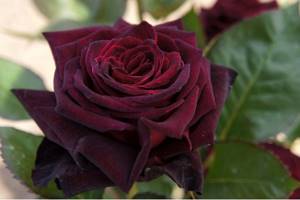
Landing
Most varieties of bush roses are unpretentious, but they also require careful care. Shrub roses can be grown throughout the country, especially in areas where other types of roses typically cannot tolerate cold, windy winters and long periods of lack of light. But you still need to take into account that not a single variety of roses can withstand constant drafts and constant shading. The place where you plan to plant flowers should have sunshine for at least 6 hours a day.
After deciding where to plant the bush rose, you need to choose the planting time: spring or autumn. In the spring, the pink bush rose is planted and sold as a set of roots wrapped in peat moss or a similar material that retains moisture well. It is best to buy pink roses, as they are either in the stage of suspended animation or are just beginning to “wake up”. You can also choose container-grown roses, which are slightly more expensive than pink roses, but are easier to plant. To do this, it is enough to dig a hole in the ground twice as wide (but not deeper) than the container itself. First you need to remove the rose bush from the container and loosen the roots. Then the roots are placed in the hole and covered with soil and well filled with water.
The size of the hole in which roses are planted is one of the key factors ensuring their subsequent growth and flowering. If planting bare root or container roses, you need to dig a hole deep enough and wide enough to accommodate the plant's roots and provide good drainage, as roses do not tolerate wet roots. If several rose bushes are planted together, they should be spaced at least a meter apart to give the plants enough space as they grow.
After planting roses, it is important to water them regularly, especially if planting in late spring or summer when they are most susceptible to drying out. Regular watering of newly planted roses is especially important for the first two to three weeks. Along with watering, it is also necessary to carry out mulching, since mulch acts as a reliable barrier against pests, helps retain moisture in the soil and generally improves the condition of the soil.
In the autumn, before planting a bush rose, it is necessary to prepare at least a couple of months in advance. When the groundwater level is high, a raised flower bed is built to prevent dampness of the soil, and therefore possible stunting and rotting of the bushes. In Russian latitudes, the soil is rarely “ideal” for any type of rose, so you need to carefully prepare the soil before planting, since the health and beautiful flowering of the rose depends on its composition. Therefore, when digging, humus is added to the soil (one square meter bucket of peat and compost (10 liters), 400-500 grams of bone meal and wood ash, 30-50 grams of superphosphate. If the soil is clayey, sand is added there (per 1 square meter 1-2 buckets of sand) After planting, seedlings are carefully covered with soil before winter.
You also need to know:
- Roses prefer soil rich in organic matter.
- Roses require well-drained soil, otherwise the rose roots will rot in standing water.
- Roses prefer a minimum of 6 hours or more of sun per day. Although the bushes will bloom, there will be fewer flowers and fewer flowers due to a decrease in the amount of sun.
- Fertilizing the soil in the area where rose bushes grow begins in mid-May and continues at least until mid-August.
- If peat products are used as mulch around roses, provide the roses with additional nitrogen as bark depletes the nitrogen content of soils.
- If the garden is characterized by good soil, which is regularly replenished with compost or other organic or inorganic fertilizers, it is important to prevent extreme oversaturation with them. This can lead to roses producing fewer flowers and suffering from root injury, which can eventually lead to their death.
Are bush roses easy to care for?
Shrub roses grow quite quickly, becoming strong, hardy plants, they are not too picky, and caring for bushes is much easier than standard or climbing roses. And compared to indoor roses, outdoor bush roses look like real “Spartans”, capable of withstanding any weather conditions and living conditions.
In order for rose bushes to develop well and delight you with beautiful, intense flowering, it is advisable to plant them in a sunny place, protected from the wind, with deep groundwater. Roses love heavy, humus-rich, slightly acidic soil that is well-drained. When planting, you need to maintain a certain distance between seedlings, depending on the variety of roses.
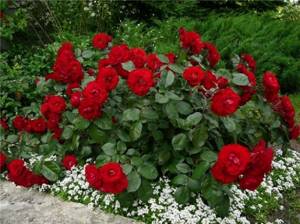
Water shrub roses sparingly as the soil underneath dries out.
Basic care for shrub roses involves regular pruning:
- in the year of planting the seedling, first the resulting buds are removed (in the second half of summer the buds are allowed to bloom) until they are the size of a grain, and also strongly growing shoots are pinched;
- in subsequent years, in the spring, damaged and weak shoots are pruned, those from the crossing branches whose bark is darker are removed;
- strong branches growing in the center of the bush are cut out;
- frozen buds on the left shoots are removed until the bud is well swollen;
- in summer, dried shoots and faded flowers are cut off along with the peduncle;
- to prevent the development of diseases and ensure ventilation of the bush, blind shoots are cut out;
- those branches that violate the outline of the crown are also pruned.
Video about caring for bush roses
During the season, it is necessary to remove fallen leaves and petals from the bushes, as they quickly rot, impairing the aesthetic appeal of the bush and contributing to the development of diseases.
Water shrub roses sparingly as the soil underneath dries out. During the summer, the plants are fed twice with phosphorus-potassium fertilizers. For the winter, it is enough to hill up the bushes; it is not necessary to cover them.
Watering and fertilizing planted roses
Shrub roses do not need excessive moisture: they are watered as the soil in the area dries out. That is, roses are not watered often, but always abundantly (except for first-year bushes). Intensive watering occurs in spring, when leaves and new shoots begin to grow. Flowers also require frequent watering in dry, hot summers.
The standard amount of water for irrigation is 10 liters for each adult bush. It is preferable to water in the early morning or evening (especially in the summer before or after the onset of heat).
It is necessary to water carefully so as not to wash away the soil, and not with cold water. After the end of the flowering period, the standard water rate is reduced to avoid stagnation of water in the soil. Before wintering, however, the soil must be saturated with moisture.
A special variety of bush roses, the so-called water roses, are watered at least twice a week, and more often if the soil dries out quickly (especially in hot, windy weather).

Shrub roses - care and cultivation
Watering bush roses
Adult plants have a long root system, therefore, such seedlings do not need frequent watering. Such roses are watered rarely, but abundantly, but frequent, but light watering is very harmful for bush roses.
Lack of moisture negatively affects roses and this affects, first of all, flowering. Due to lack of moisture in bush roses, flowering decreases, flowers are formed small or deformed, or there is no flowering at all.
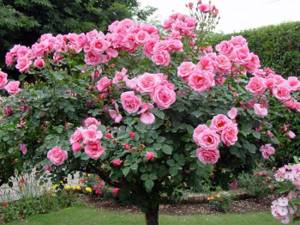
Shrub roses
Therefore, on hot summer days, roses are watered every week, and recently planted roses are watered more often until they take root.
You should not water roses with cold water, especially in hot weather.
Water for irrigation is settled in advance so that the chlorine evaporates from it.
Shrub roses
Some gardeners recommend watering bush roses with rainwater, but I think this is unsafe. Nowadays, a rain cloud can fly in from an unfavorable area and watering with such water can cause harm to the plant. Rainwater needs to be purified before irrigation, and this is quite difficult to do under normal conditions.
You cannot water roses with water taken from swamps and other open bodies of water. Such water contains many pathogenic bacteria and microorganisms.
Reproduction
Reproduction of bush roses, like most other types of roses, occurs through seeds and vegetative propagation.
- Reproduction using seeds. This type of propagation is used when breeding unknown and hybrid varieties. At the same time, seed propagation is practiced only for wild roses, since not all flowers produce viable seeds. The seeds are prepared only in the reddening phase of the fruit. By next spring, they are kept for several hours in a special root formation stimulator. Over time, they are sown in prepared soil to a depth of 2 cm and covered with mulch and peat. After two full-sized leaves appear in the shoots, they are placed at a distance of 7 cm from each other.
- Vegetative propagation. This is the easiest way to propagate bush roses. Wood shoots are used for this. Cuttings are cut at the beginning of the flowering period, when the roses harden. Correct cuts must meet the following conditions:
- thickness as a pencil;
- length - 8 cm;
- the upper incision is straight, 1 cm above the kidney;
- the lower incision is at an angle of 45 degrees, below the kidney.
All thorns and leaves are removed from below. The top leaves are cut in half. The cut from below is treated with phytohormones before planting. The cuttings are placed in sand at a distance of 20 cm from each other. It is better that the landing site is in the shade. The depth of the trench should be 15 cm. After sowing, the sand is compacted and watered.
For faster “survival” of cuttings, it is recommended to create a greenhouse or cover the cuttings with film. Periodically the cover is raised to ventilate the cuttings. From the time of sowing until the rooting cuttings are not watered, buds may appear on them, which must be immediately removed so that the plant does not waste energy on flowering. In winter, the cuttings are covered with film on top. Most cuttings are grown for 2 years, and only in the third year can the seedlings be transplanted.
Important! When replanting a cut, care should be taken to ensure that the roots of the rose do not bend upward. All roots should be strictly directed downwards.
Facts about bush roses

Shrub rose
Before you start growing these wonderful flowers at home or in the country, especially if you don’t have much experience with roses, you should familiarize yourself with the nature of the plant:
- This species is highly frost-resistant, but this does not exclude the need to prepare for wintering by wrapping it up. Hybrid tea and floribunda varieties do not require a lot of material and effort.
- There is an opinion that a bushy rose requires frequent care, but this is not entirely true. Everything comes down to the banal need for annual crown formation and periodic cleaning of dead branches. Complementary feeding will not be superfluous.
- In autumn, pruning of re-blooming shrubs is mandatory. It is worth noting that not all types belong to them.
- The stems of the plant are full of thorns, the wounds from which heal for a long time and are very unpleasant.
- Climbing bush roses can be grown as a hedge, but this venture will be more successful if the base is a large chain-link or wooden frame.
- Home mini-bushes require a maximum of 60 cm of distance between each other. They are often planted in the ground with a pot and taken away for the winter.
- Large species look great in single or complex plantings, but when planning a rose garden, you need to maintain a radius of up to 1.5 m from each “tenant”.
Having decided on the purpose of the flower and the variety, all that remains is to choose the right source so that even a beginner can grow a healthy plant.
Park rose: planting and care in open ground
Pruning roses
One of the great advantages of shrub roses is that they are designed to bloom for a considerable period of time, maintaining blooms all summer long until frost. They really don't need constant pruning. It is common to do a thorough pruning at the beginning of the season and trim off the "dead" parts of rose bushes before winter.
In order for a bush rose to please the eye with beautiful flowering, with a neat shape of the bush, it is necessary to take into account some rules for pruning them:
- To strengthen the root system and shoots, the first buds of the rose are cut out.
- In spring and summer, very large and damaged buds are removed, which prevent the correct formation of the bush.
- At the end of flowering, you also need to remove faded buds;
- To thin out the bush and avoid the appearance of diseases, it is recommended to eliminate dry buds that have stopped growing;
- It is important to cut out buds that change the appearance of the bush's crown.
Shrub roses need support (support, which will help solve several problems:
- The branches do not lie on the ground, and the buds remain clean;
- Bushes more easily tolerate natural “hardships” (for example, frozen soil in winter);
- The crown can be given the correct shape.
When choosing a rose support, it is important to read reviews and understand in which case you should choose one type of support or another. In addition, support can be done with your own hands from improvised means, the main thing is that, like flowers, it can provide a decorative function that beautifies the garden.
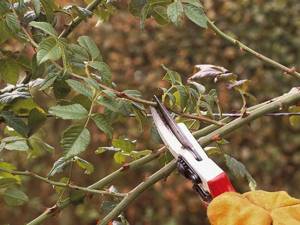
Diseases and pests of bush roses
Even under good conditions and proper care, roses need protection from diseases and pests. The most common ones are:
- Black spot. This disease looks like this - unsightly dark brown, gray spots on the foliage. This disease can be prevented by using a fungicide specifically formulated for use on roses during periods of cool, wet weather. Also, to avoid this disease, do not plant roses too close to each other, and make sure that they have enough sun, and when watering it is important to try to avoid getting water on the foliage.
- Powdery mildew. It looks like gray or white fuzzy spots on the leaves. A fungicide is used to prevent it. To avoid this, it is important to plant the rose in well-ventilated and sunny areas of the garden.
- Japanese beetles. These insects can eat almost all the foliage and flowers from a rose plant in just a couple of days. In the case of a small number of beetles, they are selected by hand and placed in soapy water. If the infestation is significant, garden insecticides containing carbaryl or permethrin are sprayed.
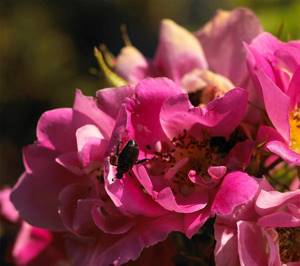
- Aphid. It is a tiny insect present in entire colonies on rose bushes. If they are small, it is enough to remove them with a strong stream of water from a hose. For larger infestations, a garden insecticide containing carbaryl or permethrin is again used.
Gardening tip: Choose roses that are appropriate for your region; they will tolerate diseases better and are more resistant to pests. You can also purchase varieties that are labeled as disease-resistant, but disease resistance does not mean disease-free.
Main varieties of shrub roses
By growing varieties with different flowering periods and different colors, you can create beautiful compositions from bush roses that will delight the eye with a rich color palette and wonderful aroma throughout the summer. Spreading rose bushes look great both as a single plant in the center of the rose garden, and planted in groups on the site or in rectangular and square ridges. But for decorating intricate flower beds with corners, curls and fancy patterns, spray roses are not suitable.
Choose the varieties of bush roses that you like best and grow them in your area, taking into account the care features.
Video about varieties and choice of roses
A generally accepted classification of roses in the world has not yet been developed, and sometimes one can easily get confused in the varieties and varieties. Thus, bush roses are sometimes called park roses, although in fact they are two different species, and hybrid tea, climbing and ground cover roses are sometimes also classified as bush species. Let us consider below those species that form lush bushes, generously showered with rose flowers: floribunda, grandiflora, park, bush and polyantha roses.
Park
This group includes various varieties and forms of cultivated rose hips used in landscape gardening. Under favorable growing conditions, park roses form spreading, densely leafed shrubs up to one and a half meters high, blooming from the beginning of June for at least one month.
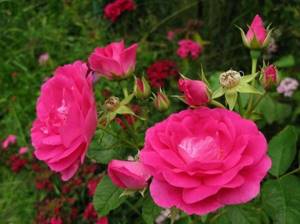
Park roses are valued by domestic flower growers not only for their decorative properties, but also because they do not require shelter for the winter.
Most varieties of park roses have white and purple flowers, orange and yellow shades are less common, and the flowers are mostly double. Park roses are very beautiful in summer, planted singly, in groups or in borders and hedges. They look no less elegant in the fall, when the fruits appear and the leaves turn autumn colors. Park roses are valued by domestic flower growers not only for their decorative value, but also because they do not require shelter for the winter.
Bush
Also a combined group, in which new varieties appear every year. Shrub roses are spreading shrubs up to two meters or more in height, with double and semi-double flowers. Modern varieties of bush roses vaguely resemble cultivated rose hips, but in color, doubleness and size of flowers, as well as in the duration and intensity of flowering, they are noticeably superior to their ancestors. Some varieties of park roses bloom only once per season, while others produce flowers several times during the summer.
Polyanthaceae
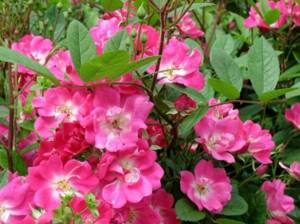
Polyantha roses
Low-growing polyanthus roses with lush inflorescences of miniature semi-double and double flowers were very popular at the beginning of the 20th century, until they were replaced by floribunda roses. But even now in landscape design, when creating group plantings and bright flower borders, they are used quite often.
The undoubted advantages of polyanthus roses include their ability to bloom profusely and almost continuously until late autumn, resistance to fungal diseases, dampness and frost. Strongly branched dense bushes grow up to 40 cm (maximum 60 cm), the color of the flowers can be white, pink, orange, red. The peculiarity of polyanthus roses is the absence of aroma.
Floribunda
As a result of crossing hybrid tea roses and polyantha roses, magnificent floribunda roses were obtained. From polyantha roses, the new species inherited the beautiful shape of the bush, multi-flowering, the ability for continuous intensive flowering, disease resistance and winter hardiness. From hybrid tea roses to floribunda roses, a wide palette of flower shades, fullness and delicate aroma have passed.
Now floribunda roses include various varieties with a bush height from 30 cm to 120 cm, with few and multi-flowered inflorescences, with double, semi-double and single flowers of yellow, red, orange, coral, lavender, white and other shades.

Rose floribunda
Grandiflora
Similar in shape and size of flowers to hybrid tea roses, grandiflora roses bloom as long and profusely as floribunda roses, but are superior to both species in terms of growth vigor and resistance to cold. Flowers collected in small inflorescences often have no aroma; the color of the flowers can be red, pink, coral, golden, etc. Grandiflora rose bushes grow up to two meters in height and can often be found in gardens and parks.
"Wintering" of roses
For northern regions, careful protection of rose bushes in winter is required. Regardless of which method of protecting roses from the cold is used, you must wait until the soil freezes (so that the flowers can gradually “get used” to such a climate).
Ways to prepare a bush rose for winter:
- Mulch. Cover the pink canes with 5-6 cm of loose mulch such as weed straw, pine needles or wood chips.
- Cones. The roses are completely covered with foam cones, after loosening and covering the rose stems with soil. It is necessary to make several ventilation holes in the cone and secure them so that they do not blow away during winter storms.
- Containers. Flowers grown in a container are moved to a more protected location, such as an unheated garage or cool basement in winter.

Cut roses
Of course, one of the greatest pleasures of planting garden roses is watching them bloom. Roses have long been prized for their beautiful and fragrant cut flowers, but the most beautiful of them all are, by far, hand-grown roses. Here are a few rules to ensure that cut roses last much longer:
- Roses will last longer if they are cut just after the bud stage, when the petals begin to open.
- For cutting, use hand pruners or garden shears with sharp blades to cut the stems without damaging their water absorption channels.
- Roses are cut early in the morning or evening, when they are fresh and hydrated after dew, so the plant is not stressed by hot weather and sun.
- Rose stems should be turned over right before placing them in a vase, this is necessary to eliminate air bubbles that will prevent moisture from flowing. The stems are cut at a 45 degree angle so that they do not lie at the bottom of the vase.
- The lower leaves that fall below the water line are cut off to prevent the growth of rot and bacteria. On the contrary, as many leaves as possible are left above the water.
- It is necessary to change the water more often - daily, if possible - to avoid the appearance of various bacteria. You should also trim the flower stems every few days to improve their water absorption.
So, spray roses are unique flowers that combine both unpretentiousness and extreme beauty. Many varieties allow you to choose a rose for any color, height and shape. And therefore, even a novice gardener, knowing how to properly care for bush roses, will be able to create a real rose garden on his site.

